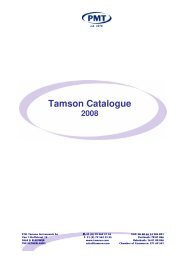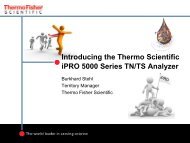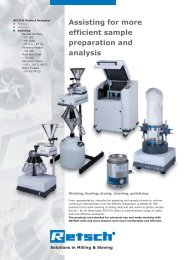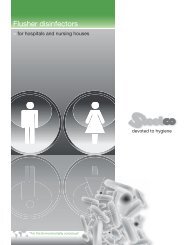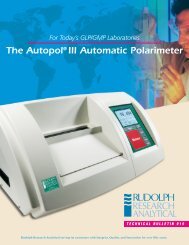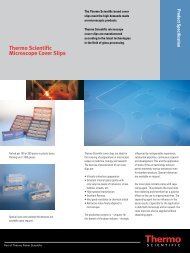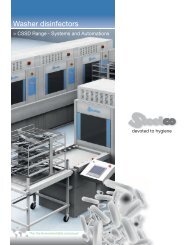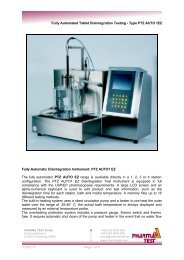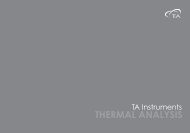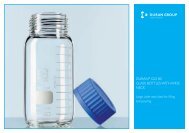TAM AIR Brochure - TA Instruments
TAM AIR Brochure - TA Instruments
TAM AIR Brochure - TA Instruments
You also want an ePaper? Increase the reach of your titles
YUMPU automatically turns print PDFs into web optimized ePapers that Google loves.
<strong>TA</strong> <strong>Instruments</strong><br />
<strong><strong>TA</strong>M</strong> <strong>AIR</strong>
New Castle, DE USA<br />
Lindon, UT USA<br />
Elstree, United Kingdom<br />
Shanghai, China<br />
Beijing, China<br />
Taipei, Taiwan<br />
Tokyo, Japan<br />
Seoul, Korea<br />
Bangalore, India<br />
Paris, France<br />
Eschborn, Germany<br />
Brussels, Belgium<br />
Etten-Leur, Netherlands<br />
Sollentuna, Sweden<br />
Milano, Italy<br />
Barcelona, Spain<br />
Melbourne, Australia<br />
Mexico City, Mexico
<strong><strong>TA</strong>M</strong> <strong>AIR</strong><br />
Technical Specifications 7<br />
<strong><strong>TA</strong>M</strong> Technology 8<br />
<strong><strong>TA</strong>M</strong> Ampoules 10<br />
Applications 12
<strong><strong>TA</strong>M</strong> <strong>AIR</strong> Isothermal microcalorimetry<br />
The ideal tool for large scale calorimetric experiments,<br />
capable of measuring 8 samples simultaneously
A POWERFUL TOOL FOR THE STUDY OF<br />
CEMENT HYDRATION PROCESSES<br />
Instrument of choice for standardized testing on cement<br />
Determining the heat of hydration of cement is important and traditionally, the heat of<br />
hydration has been determined by measuring the heat of solution (ASTM C186). More recently,<br />
isothermal calorimetry tests using <strong><strong>TA</strong>M</strong> Air are increasing because it accurately and reliably<br />
measures the heat of hydration (ASTM C1702). The samples tested in the <strong><strong>TA</strong>M</strong> Air are usually<br />
paste samples, where the cement hydration process can continuously be followed over time. The<br />
shape of the heat flow curve will reflect the cement hydration process and the different phases of<br />
the complex process can be determined. The addition of admixtures will change the shape of the<br />
heat flow curve, and the admixture effect can be quantified. The integrated heat flow over time will<br />
give the extent of hydration. Using isothermal calorimetry, the heat of hydration is measured with<br />
<strong><strong>TA</strong>M</strong> Air by monitoring the heat flow from the specimen while both the specimen and the surrounding<br />
environment are maintained at the same temperature. The <strong><strong>TA</strong>M</strong> Air is widely used for<br />
studying the reaction kinetics of pure cement pastes as well as the temperature dependence<br />
of the reaction. <strong><strong>TA</strong>M</strong> Air is an excellent tool for quality control in cement plants, for optimization<br />
of additives to give a cement a certain property as well as a general research tool for the<br />
cement laboratory.<br />
Phase 1: Rapid initial process - Dissolution of ions and initial hydration<br />
Phase 2: Dormant period - Associated with a low heat evolution and<br />
slow dissolution of silicates<br />
Phase 3: Acceleration period - Silicate hydration<br />
Phase 4: Retardation period - Sulphate depletion and slowing down of<br />
the silicate hydration process<br />
Heat Evolution / mW/g<br />
5<br />
4 1<br />
3<br />
3<br />
2<br />
1<br />
2<br />
0<br />
0 10<br />
4<br />
20 30 40 50 60<br />
Time (h)<br />
4 5
<strong><strong>TA</strong>M</strong> <strong>AIR</strong><br />
SPECIFICATIONS<br />
Thermostat Specifications<br />
Calorimeter Positions 8<br />
Operating Temperature Range 5 - 90 °C<br />
Thermostat Type<br />
Air<br />
Thermostat Stability ± 0.02 °C<br />
Limit of Detection 4 µW<br />
Precision ±20 µW<br />
Calorimeter Specifications<br />
Short Term Noise < ± 2.5 µW<br />
Precision ± 20 µW<br />
Baseline over 24 hours<br />
Drift
<strong><strong>TA</strong>M</strong> <strong>AIR</strong> Technology<br />
Monitoring the thermal activity or heat flow of chemical, physical and biological processes provides information which cannot be generated with other techniques.<br />
Isothermal microcalorimetry is a powerful technique for studying heat production or consumption and is non-destructive and non-invasive to the sample. The <strong><strong>TA</strong>M</strong> Air<br />
offers unmatched sensitivity and long term temperature stability with flexible sample requirements.<br />
When using microcalorimetry there is little or no sample pretreatment required; solids, liquids and gasses can all be analyzed. Unlike other techniques that may only<br />
give time interval snapshots of data, microcalorimetry presents continuous real-time data that reflects the process or processes taking place in the sample.<br />
High Performance Temperature Control and Stability<br />
The <strong><strong>TA</strong>M</strong> Air is an air based thermostat, utilizing a heat sink to conduct the heat<br />
away from the sample and effectively minimize outside temperature disturbances.<br />
The calorimeter channels are held together in a single removable block. This block<br />
is contained in a thermostat that uses circulating air and an advanced temperature<br />
regulating system to keep the temperature very stable within ±0.02°K. The high<br />
accuracy and stability of the thermostat makes the calorimeter well suited for heat<br />
flow measurements over extended periods of time, e.g. weeks. The baseline drift<br />
is less than 40 µw/24 hours with very low short term noise. <strong><strong>TA</strong>M</strong> Air Assistant,<br />
a powerful, flexible and easy-to-use software package is used for instrument control,<br />
experimental setup, data analysis and reporting of results.<br />
Isothermal Microcalorimetry<br />
When heat is produced in a sample, isothermal microcalorimetry measures<br />
the heat flow. The sample is placed in an ampoule that is in contact with<br />
a heat flow sensor that is in also in contact with a heat sink. When heat<br />
is produced or consumed by any process, a temperature gradient across<br />
the sensor is developed. This will generate a voltage, which is measured.<br />
The voltage is proportional to the heat flow across the sensor and to the<br />
rate of the process taking place in the sample ampoule. This signal is<br />
recorded continuously and in real-time.<br />
For each sample there is a reference that is on a parallel heat flow sensor.<br />
During the time that the heat flow is monitored, any temperature fluctuations<br />
entering the instrument will influence both the sample and the reference<br />
sensors equally. This architecture allows a very accurate determination<br />
of heat that is produced or consumed by the sample alone while other<br />
non-sample heat disturbances are efficiently factored out.<br />
<strong><strong>TA</strong>M</strong> Air 8-Channel Calorimeter<br />
The <strong><strong>TA</strong>M</strong> <strong>AIR</strong> 8 Channel calorimeter consists of an<br />
eight (8) channel calorimeter block and data<br />
logging system required for use with the <strong><strong>TA</strong>M</strong> <strong>AIR</strong><br />
thermostat. The calorimeters are twin-type (sample and<br />
reference), and designed for use with 20 ml glass or plastic<br />
ampoules or the 20 ml Admix ampoules.<br />
8 9
<strong><strong>TA</strong>M</strong> Air Ampoules<br />
The ampoules used in the <strong><strong>TA</strong>M</strong> Air are designed to handle up to 20 ml volumes. Either glass, stainless steel or plastic (HDPE) closed ampoules are available,<br />
which enables maximum flexibility for sample management and maximum sensitivity.<br />
Admix Ampoule<br />
The Admix Ampoule is a 20 ml accessory available for initiating<br />
reactions inside the calorimeter, and can be used for monitoring<br />
a reaction from the initial injection. The Admix ampoule can be<br />
configured with or without a motor for stirring. For suspensions such<br />
as mixtures of cement and water, manual stirring is recommended.<br />
For liquid systems, a motor may be used for stirring. The admix ampoule<br />
can only be used with 20 ml disposable glass ampoules.<br />
10<br />
11
Applications<br />
Cement Paste Setting Time<br />
The synergy of citric acid (CA) and calcium nitrate (CN) is<br />
clearly seen from the rate of hydration heat. CA is essentially a<br />
setting retarder relative to the reference, although the heat of<br />
hydration is slightly reduced and CN is clearly a setting accelerator.<br />
Together they behave as a hardening retarder lowering the rate of<br />
hydration heat and distributing it over a longer time.<br />
The rate of hydration heat for the same mixtures at 40 °C shows<br />
that the function as hardening retarder is reduced at higher<br />
temperature. This data along with the cumulative heat data indicate that<br />
the admixture combination may not function in the practical semiadiabatic<br />
case of massive concrete. 1<br />
Rate of Hydration Heat (mW/g Cement)<br />
Rate of Hydration Heat (mW/g Cement)<br />
4<br />
3.5<br />
3<br />
2.5<br />
2<br />
1.5<br />
1<br />
0.5<br />
0.00<br />
0<br />
4<br />
3.5<br />
3<br />
2.5<br />
2<br />
1.5<br />
1<br />
0.5<br />
0.00<br />
0<br />
Isothermal Calorimetry of Paste at 20 ˚C<br />
0.15% CA<br />
0.15% CA/1.5% CN<br />
Reference<br />
1.5% CN<br />
6 12 18 24 30 36 42 48<br />
Time (h)<br />
Isothermal Calorimetry of Paste at 40 ˚C<br />
0.15% CA (AN)<br />
0.15% CA+1.5% CN (AN)<br />
Reference (AN)<br />
1.5% CN (AN)<br />
6 12 18 24 30 36 42 48<br />
Hydration of Calcium Sulfate Hemihydrate<br />
Identical samples of 2g of Calcium Sulfate Hemihydrate powder were<br />
mixed with a hydrating agent at a liquid to solid ratio of 0.50 using<br />
an admix ampoule in the <strong><strong>TA</strong>M</strong> Air. The blue curve shows a sample<br />
hydrated with deionized water. The red curve is a sample hydrated<br />
with a 5% Sodium Chloride solution. It is demonstrated that sodium<br />
chloride accelerates the calcium sulfate hydration reaction.<br />
Normalized Heat Flow (W/g)<br />
6.00<br />
5.00<br />
4.00<br />
2.00<br />
1.00<br />
0.00<br />
0.0<br />
0.2<br />
0.4 0.6 0.8 1.0 1.2<br />
Time (hr)<br />
Time (h)<br />
12<br />
13
Applications<br />
Cement Sulfate<br />
This figure shows<br />
depletion peak<br />
peak – can be used<br />
sulfate content of<br />
of the laboratory<br />
that 2.5% added<br />
bring the resulting<br />
SO 3 level. Several<br />
in the field to perform<br />
ground cement.<br />
Calorimetry serves<br />
approximate values<br />
admixture incompatibility<br />
or changes in raw<br />
reactivity of the aluminate<br />
for soluble SO 3 . 2<br />
can be used to assess<br />
to the cement production,<br />
Cement Thermal Profiles with Contaminants<br />
Cement setting thermal profiles can be influenced by<br />
contaminants. The graph shows the steady decrease in<br />
thermal power as the contamination of the cement mortar<br />
by a mixture of soil and sawdust increases (0; 0.9; 2.5 and<br />
5.9% of w/c=0.6 cement mortar). Influence on hydration<br />
rate of a mixture of soil and sawdust. 3<br />
Setting Time of Cement<br />
The <strong><strong>TA</strong>M</strong> Air calorimeter has been shown to be excellent<br />
for diagnosis of problems related to setting time and<br />
premature stiffening of cement. The blue curve in the figure to<br />
the right represents an industrial cement produced with too little<br />
soluble calcium sulfate. This cement suffers from early<br />
stiffening because of the aluminate reactions at 1–1.5 hours<br />
hydration indicated by the unusually small silicate peak at<br />
5-10 hours. When 0.5% (purple curve) and 1.0% (red<br />
curve) of calcium sulfate hemi-hydrate was added to the<br />
hydration. It also suffers from low early strength, because the<br />
aluminate hydrates formed retard the strength-giving silicate<br />
2<br />
1.5<br />
1<br />
0.5<br />
0<br />
2.5<br />
1.5<br />
1.0<br />
Depletion<br />
how Lerch’s criteria - sulfate<br />
to occur after the main silicate<br />
6.00<br />
for a rapid indication of the optimum<br />
a laboratory ground clinker. The results<br />
5.00<br />
Second Peak<br />
screening shown indicates<br />
SO 3 might be sufficient to<br />
4.00<br />
0<br />
Portland cement to optimum<br />
3.00<br />
factors may cause cement manufactured<br />
20<br />
different as compared to the laboratory<br />
2.00<br />
Sulfate Depletion<br />
1.00<br />
as an excellent indication as to the<br />
to aim for to avoid setting time and<br />
0.00<br />
issues. Furthermore, the calorimetry<br />
0 2 4 6 8 10 12 14 16 18 20 22 24<br />
the efficiency of any changes made<br />
Time (h)<br />
such as changes in gypsum type<br />
material or fuel that may influence the<br />
phase and thereby the demand<br />
cement the undesired early peak disappeared, and<br />
the strength-giving silicate peak regained its normal shape.<br />
0.5<br />
The results indicate that premature stiffening is caused by a<br />
lack of soluble calcium sulfate.<br />
0<br />
0 5<br />
Heat Flow (mW/g)<br />
Thermal Power / mW/g<br />
Heat Flow (µW/g)<br />
No Contamination<br />
Low Contamination<br />
Medium Contamination<br />
High Contamination<br />
40 60 80 100<br />
Time (h)<br />
10 15 20<br />
Time (h)<br />
14<br />
15
Applications<br />
Cement Blending<br />
0.003<br />
This figure provides plots of the heat release rate (heat flow) for the first 24 h of hydration for six cement pastes examined by Isothermal<br />
0.002<br />
calorimetry (3 pure and 3 blends). In general, results for the two replicate specimens for each cement paste fall directly on top of one another. For<br />
the three initial cements, the heat release during the first 24 h increases with increasing cement fineness, as would be expected due to the increased<br />
0.001<br />
(in contact with water) surface area. Interestingly, for these six cements based on a single clinker, the peak in heat release rate always occurs at<br />
0.000<br />
about 6 h, while by 24 h, the heat release rate has diminished to a value close to 0.001 W/g cement.<br />
The heat flows measured during the first 24 h for the three blended cements are predicted quite well by applying the simple law of mixtures. The<br />
0.007<br />
results imply that for the w/c = 0.4 cement pastes examined in this study, the particles are likely hydrating independently of one another during<br />
0.006<br />
the first 24 h, such that the degree of hydration of blends of the fine and coarse cements can be quite accurately computed simply as a weighted<br />
average of their (measured) individual hydration rates.<br />
0.005<br />
4<br />
0.004<br />
0.003<br />
0.002<br />
0.001<br />
0.000<br />
Heat Flow (W/g cement)<br />
Heat Flow (W/g cement)<br />
0.007<br />
0.006<br />
0.005<br />
0.004<br />
0<br />
0<br />
Type l/la<br />
Type l/lb<br />
Type ll/Va<br />
Type ll/Vb<br />
Type llla<br />
Type llla<br />
4 8 12 16 20 24<br />
Time (hr)<br />
50:50 Blend<br />
50:50 Estimated<br />
Type ll/V<br />
4 8 12 16 20 24<br />
Time (hr)<br />
Heat Flow (W/g cement)<br />
Heat Flow (W/g cement)<br />
0.005<br />
0.004<br />
0.003<br />
0.002<br />
0.001<br />
0.000<br />
0<br />
0.007<br />
0.006<br />
0.005<br />
0.004<br />
0.003<br />
0.002<br />
0.001<br />
0.000<br />
0<br />
4 8 12<br />
Time (hr)<br />
75:25 Blend<br />
75:25 Blend<br />
75:25 Estimated<br />
16 20 24<br />
25:75 Blend<br />
25:75 Blend<br />
25:75 Estimated<br />
4 8 12 16 20 24<br />
Time (hr)<br />
16<br />
17
Applications<br />
Food Testing<br />
This figure shows the Thermal treatment of carrot juice resulting in<br />
increased shelf life only at the highest treatment temperature.<br />
The measured thermal power is the heat from the microbiological<br />
activity in the sample. It is seen that the lower treatment<br />
temperatures gave only slightly lower thermal powers, but that the<br />
70 °C treatment gave a substantially delayed signal. At 20 °C<br />
the shelf life was thus increased by more than 50% by the 70 °C<br />
treatment. 5<br />
6<br />
Epoxy Curing<br />
5<br />
Here we see the heat production and the heat production rate as a<br />
function of time. It can be seen that the spread of results is low and that<br />
after an initial reaction period of five hours the heat production rate<br />
4<br />
decrease is similar to an exponential decay. After 45 h the thermal<br />
power is approx. 0.06 mW/g, i.e. 600 μW for a l0g sample.<br />
3<br />
As the detection limit for <strong><strong>TA</strong>M</strong> Air is better than 3 μW it would still<br />
be possible to follow the reaction for an even longer time than was<br />
2<br />
done here. 6<br />
Thermal power / mW<br />
log (Heat Production rate, mW/g)<br />
4<br />
3<br />
2<br />
1<br />
0<br />
0<br />
1<br />
fresh<br />
50˚C<br />
60˚C<br />
70˚C<br />
20 40 60 80 100 120<br />
Time (h)<br />
0<br />
0 20 40<br />
(Time, h)<br />
Fungal Growth<br />
At each temperature multiple inoculated specimens were<br />
measured. This figure shows the results at the five temperatures. It<br />
is seen that the results for each temperature agrees rather well with<br />
each other. Calorimetric measurements can be a valuable addition<br />
to the measurement techniques for predictive microbiology. 7<br />
<strong><strong>TA</strong>M</strong> Air Battery Testing<br />
The properties of batteries during discharge with three different<br />
resistance loads are shown. Single channels in <strong><strong>TA</strong>M</strong> Air<br />
were charged with 1.5 V alkaline batteries, size AAA. Three<br />
resistors of different values were placed in an adjacent channel<br />
500<br />
for connection to the batteries. The solid line represents the<br />
useful energy in the battery which is the heat production<br />
measured in the resistor, while the dotted line is the heat production<br />
0<br />
from the battery itself, i.e. the internal losses.<br />
300<br />
The batteries were fully discharged during the course of the<br />
200<br />
evaluation in the <strong><strong>TA</strong>M</strong> Air. The lowest resistances cause a<br />
100<br />
rapid drain of the battery (e.g. as in a flashlight) whereas the<br />
highest resistances cause a very low rate of discharge (e.g. as in an<br />
0<br />
alarm clock). 8<br />
Thermal power / µW<br />
Heat Production Rate, mW<br />
700<br />
600<br />
500<br />
400<br />
300<br />
200<br />
100<br />
50<br />
0<br />
0<br />
25˚C<br />
20˚C<br />
15˚C<br />
50 100 150 200<br />
Time (h)<br />
1.35 R/Ω<br />
0 0.5 1 1.5<br />
11.2 R/Ω<br />
0 5 10 15<br />
33.4 R/Ω<br />
0<br />
0 10 20 30 40 50 60<br />
Time, h<br />
30˚C<br />
10˚C<br />
18<br />
19
NOTES<br />
1<br />
Justness, H., Wuyts, F. and D. Van Gemert. Hardening Retarders for Massive Concrete. Thesis. Catholic University of Leuven. 2007<br />
2s22<br />
Paul Sandberg, Grace Construction Products, W. R. Grace & Co. 2004.<br />
3<br />
Dr. L. Wadsö, University of Lund, Sweden 2002<br />
4<br />
Bentz, D.P. Blending Different Fineness Cements to Engineer the Properties of Cement-Based Materials. Mag. Concrete Res.<br />
5<br />
F. Gomez and L. Wadsö. Isothermal Calorimetry for Biological Applications in Food Science and Technology. 2000.<br />
6<br />
Wadso, L. Curing of Epoxy Adhesive Studied by <strong><strong>TA</strong>M</strong> Air. <strong>TA</strong> <strong>Instruments</strong> Application Note 2007<br />
7<br />
Lars Wadsö and Yujing Li. A test of models for fungal growth based on metabolic heat rate measurements. 2000<br />
8<br />
Lars Wadso. Investigations into Dry Cell Battery Discharge Rates using <strong><strong>TA</strong>M</strong> Air. 2000. <strong>TA</strong> <strong>Instruments</strong>, AN 314-03.
tainstruments.com<br />
© 2011 <strong>TA</strong> <strong>Instruments</strong>. All rights reserved. L20037.001




